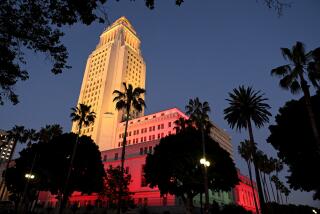L.A. Area Chamber Sheds Its Low Profile and Gets Down to Business
- Share via
The chairman and the president of the Los Angeles Area Chamber of Commerce climbed to new heights on a recent afternoon--up about 6 feet.
Chairman David E. Anderson and President Ray Remy, with safety belts tightly cinched, climbed a ladder to sign a traveling billboard designed to kick off the chamber’s campaign to improve the 3,500-member organization’s visibility and to upgrade its image as a business advocate.
Remy, who has been president since last April 17, has spent the last year consolidating and solidifying the chamber’s internal structure, and setting goals for the organization’s departments, spokeswoman Laura Fredricks-Segall said.
“Now we’re ready to get down to some serious business,” she said.
The 14-by-48-foot billboard, which reads “We mean BUSINESS,” will move to various parts of the city during the next year. The billboard, donated by the Foster & Kleiser billboard advertising firm, now sits at the southwest corner of Figueroa and Pico, across from the Convention Center.
Also included in the chamber’s “image campaign” are a series of networking meetings called “Business After Hours,” efforts to draw employees of member companies into chamber activities, and increased contact between chamber executives and members, Fredricks-Segall said.
In 1985, the chamber intends to work more closely with government agencies and to focus on six priority issues selected by the board of directors, she said.
Those issues are: job creation and retention, Southern California’s water supply, toxic and hazardous waste, housing, the quality and funding of public education and mass transit. In addition, international trade and commerce was selected as an “issue of ongoing concern,” she said.
Former Los Angeles Deputy Mayor Remy’s tenure as president hasn’t been characterized by the controversy that followed his predecessors.
As part of an effort to bring the chamber into a new era of advocacy, the organization hired former Pepperdine University President William S. Banowsky in September, 1982, to be the 97-year-old chamber’s first full-time salaried president. The title of the top elected official was changed to chairman.
But Banowsky quit after only six weeks to return to his job as president of the University of Oklahoma. Banowsky’s successor, Ted Bruinsma, an unsuccessful candidate for the 1982 California Republican nomination for U.S. Senate, lasted one year in the position.
At the time of Bruinsma’s resignation in mid-January, 1984, chamber insiders said that part of the problem had been that no one could agree on what role the president should play--that of visible spokesman, inside manager, or some combination.
More to Read
Sign up for Essential California
The most important California stories and recommendations in your inbox every morning.
You may occasionally receive promotional content from the Los Angeles Times.










